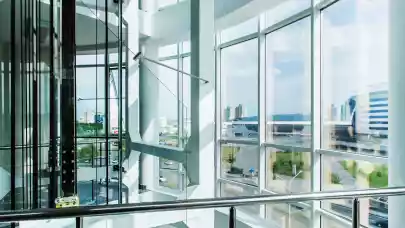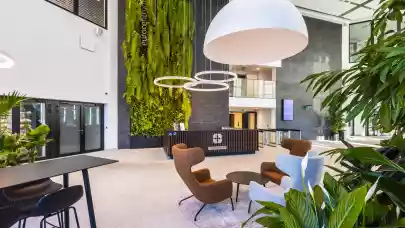
Knight Frank has been present in Hungary since 2018, mostly focusing office leasing – a process that will significantly be impacted by COVID-19. Erika Lóska, Head of Office Division at Knight Frank Hungary and Colin Fitzgerald, Partner International Occupier Services at Knight Frank London talked to Property Forum about the company’s plans for Hungary and how COVID-19 could change the occupier services sector.
Knight Frank has been present on the Hungarian market for nearly two years. How has it been building up the brand locally?
Erika: It is always a big step and a challenging project to enter into an established market. We are proud that under such tough competition, we still managed to increase our brand awareness on the market. Our clients welcomed us on the Hungarian market and not only we have been asked to help them in occupier services, but also we supported our clients in many other areas, such as valuation, investment and landlord representation in office or in industrial fields. Due to the increasing business our office was engaged with, we have decided to expand our office team, with both senior and junior colleagues. Currently, we are quite satisfied with our pipeline, being the second year, and as we clearly see the opportunities for 2020-2021, we stay positive and plan further expansion in our team.

So far, you’ve focused on office leasing. Do you plan on covering other market segments?
Erika: Our main focus in Hungary was office leasing and still is. However, it is worth to mention that we have been involved in several other segments as well, such as industrial, investment or valuation. Even now, we are currently the exclusive agent to sell ABB’s plant in Ózd. Working in these other service lines constantly bring great results, so we definitely plan to expand. As you probably know, we at Knight Frank are long-time players and world-renowned in our tailored residential property services, especially when it comes to high-end/premium projects. We are planning to add this service line to the Hungarian market as well, should the right time come.
What are your projections for this year? How will the coronavirus pandemic affect the property sector and your Hungarian operations?
Erika: We are constantly monitoring the market and analysing our clients’ reactions to the situation. There are several possible outcomes but what we currently see is that our clients are more cautious and despite the previous dynamic economic growth and the overall optimism, now they certainly want to be sure that they limit their risks. They have good experience from previous challenging times, which prepared them, however, these times are rather unprecedented and they should all take proper measures in tackling the next steps. We are in the process of preparing cost calculations and project analysis, and we believe this is going to be more common: the role of the advisors is getting even more important. We can help our clients in evaluating possible scenarios and find the best way to optimize their future commitments. As an example, most of our clients have implemented the new work from home structure in such a short time and so effectively, that the question arose naturally: what is the exact office size they really need? What is the percentage of the actual workplaces that must be kept in the office and what part of it can be really turned to home office? Are we ambitious enough? What flexibility can we build in the agreements and what can we do with the long-term commitments? There are so many questions where we have experience and we could help to analyse the situation of our clients, define the best option to them and help them to achieve it. We believe that advanced occupier services in any segments of the market will be very important again both for tenants and landlords.
Colin: COVID-19 will have a lasting effect on the way we work. In the short term, many office-based businesses will be required to reconfigure their space and change working patterns to accommodate social distancing. Staff needs to feel safe. The great technology experiment has largely worked, many millions of people have successfully experienced and been productive working from home thanks to increasingly robust, secure and personalised technology. However, the pandemic has also emphasized the cultural, social and collaborative importance of the office particularly to the younger generation.
Looking forward, working patterns may well change, we can expect to see more flexible working, with the office becoming a choice, not an obligation. This lays down challenges for office designers who will need to create environments that support productivity, innovation and the culture of a business. Managers and supervisors will also need to adapt to managing staff they may not be sitting with on a daily basis.

Colin Fitzgerald
Partner International Occupier Services
Knight Frank
Erika: Our Strategic Workplace Consultancy team has launched a roadmap for re-occupying the workplace post-lockdown, a step-by-step strategy that assesses capacity and risk for safe return to work and we are applying it for several clients already around the globe. The roadmap to support occupiers in five clear areas: understanding their employee base, reviewing the employee/ customer journey within the workplace, evaluating social distancing options, determining occupancy impact and developing protocols.
The roadmap, which helps businesses determine best practice for re-occupying offices, identifies two categories of change that will need to occur in order to safely re-enter the workplace. The first is behavioural changes, ensuring that strict protocols such as clear desk policies are applied and that social distancing is possible within the workplace. The second is environmental changes including increased airflow, changing HVAC filters or enhancing cleaning regimes. In order to encourage environmental and behavioural change in the workplace there has been created clear ‘overlays’ – clear steps and floorplan guidance – to aid businesses in assessing the risk and capacity issues.
The COVID-19 ‘Risk Overlay’ identifies the spaces that present with the highest risk of contamination and creates a roadmap for how to reduce surface transmission through increased protocols. High-risk areas are identified as those that people share as part of their normal working day which could potentially increase the potential of human-to-human transition. These could include lifts, break or café areas, washrooms, printers, libraries, coat cupboards, or vending areas.
The COVID-19 ‘Capacity Overlay’ provides options on how to use space to accommodate the workforce in the office with distancing recommendations. Businesses are encouraged to develop an occupancy strategy. A comparison can then be drawn between the size and functions within an office and the number of people that are expected to be in any given office space. This can then determine which areas can be used safely. Key areas of the office which will need to be evaluated and adapted will be conference rooms, phone rooms, workstations, open breakout areas, cafeterias.
Colin: The roadmap has been created in a way that can be easily adapted. Every office and office culture are unique, therefore businesses must individually create their own strategies to implement environmental and behavioural change that will reinforce safety measures ahead of workforces re-occupying buildings.



